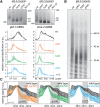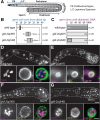Polyadenylation is the key aspect of GLD-2 function in C. elegans
- PMID: 28490506
- PMCID: PMC5513063
- DOI: 10.1261/rna.061473.117
Polyadenylation is the key aspect of GLD-2 function in C. elegans
Abstract
The role of many enzymes extends beyond their dedicated catalytic activity by fulfilling important cellular functions in a catalysis-independent fashion. In this aspect, little is known about 3'-end RNA-modifying enzymes that belong to the class of nucleotidyl transferases. Among these are noncanonical poly(A) polymerases, a group of evolutionarily conserved enzymes that are critical for gene expression regulation, by adding adenosines to the 3'-end of RNA targets. In this study, we investigate whether the functions of the cytoplasmic poly(A) polymerase (cytoPAP) GLD-2 in C. elegans germ cells exclusively depend on its catalytic activity. To this end, we analyzed a specific missense mutation affecting a conserved amino acid in the catalytic region of GLD-2 cytoPAP. Although this mutated protein is expressed to wild-type levels and incorporated into cytoPAP complexes, we found that it cannot elongate mRNA poly(A) tails efficiently or promote GLD-2 target mRNA abundance. Furthermore, germ cell defects in animals expressing this mutant protein strongly resemble those lacking the GLD-2 protein altogether, arguing that only the polyadenylation activity of GLD-2 is essential for gametogenesis. In summary, we propose that all known molecular and biological functions of GLD-2 depend on its enzymatic activity, demonstrating that polyadenylation is the key mechanism of GLD-2 functionality. Our findings highlight the enzymatic importance of noncanonical poly(A) polymerases and emphasize the pivotal role of poly(A) tail-centered cytoplasmic mRNA regulation in germ cell biology.
Keywords: germline development; poly(A) metabolism; poly(A) polymerase; translational regulation.
© 2017 Nousch et al.; Published by Cold Spring Harbor Laboratory Press for the RNA Society.
Figures




Similar articles
-
GLD-4-mediated translational activation regulates the size of the proliferative germ cell pool in the adult C. elegans germ line.PLoS Genet. 2014 Sep 25;10(9):e1004647. doi: 10.1371/journal.pgen.1004647. eCollection 2014 Sep. PLoS Genet. 2014. PMID: 25254367 Free PMC article.
-
A regulatory cytoplasmic poly(A) polymerase in Caenorhabditis elegans.Nature. 2002 Sep 19;419(6904):312-6. doi: 10.1038/nature01039. Nature. 2002. PMID: 12239571
-
Two conserved regulatory cytoplasmic poly(A) polymerases, GLD-4 and GLD-2, regulate meiotic progression in C. elegans.Genes Dev. 2009 Apr 1;23(7):824-36. doi: 10.1101/gad.494009. Genes Dev. 2009. PMID: 19339688 Free PMC article.
-
Non-canonical poly(A) polymerase in mammalian gametogenesis.Biochim Biophys Acta. 2008 Apr;1779(4):230-8. doi: 10.1016/j.bbagrm.2008.01.004. Epub 2008 Feb 12. Biochim Biophys Acta. 2008. PMID: 18294465 Review.
-
Control of poly(A) tail length.Wiley Interdiscip Rev RNA. 2011 May-Jun;2(3):348-61. doi: 10.1002/wrna.56. Epub 2010 Nov 17. Wiley Interdiscip Rev RNA. 2011. PMID: 21957022 Review.
Cited by
-
Functions and mechanisms of RNA tailing by metazoan terminal nucleotidyltransferases.Wiley Interdiscip Rev RNA. 2021 Mar;12(2):e1622. doi: 10.1002/wrna.1622. Epub 2020 Jul 22. Wiley Interdiscip Rev RNA. 2021. PMID: 33145994 Free PMC article. Review.
-
Stage-specific combinations of opposing poly(A) modifying enzymes guide gene expression during early oogenesis.Nucleic Acids Res. 2019 Nov 18;47(20):10881-10893. doi: 10.1093/nar/gkz787. Nucleic Acids Res. 2019. PMID: 31511882 Free PMC article.
-
Germline immortality relies on TRIM32-mediated turnover of a maternal mRNA activator in C. elegans.Sci Adv. 2022 Oct 14;8(41):eabn0897. doi: 10.1126/sciadv.abn0897. Epub 2022 Oct 14. Sci Adv. 2022. PMID: 36240265 Free PMC article.
-
Poly(U) polymerase activity in Caenorhabditis elegans regulates abundance and tailing of sRNA and mRNA.Genetics. 2024 Oct 7;228(2):iyae120. doi: 10.1093/genetics/iyae120. Genetics. 2024. PMID: 39067069 Free PMC article.
-
Terminal nucleotidyltransferase Tent2 microRNA A-tailing enzyme regulates excitatory/inhibitory balance in the hippocampus.RNA. 2025 May 16;31(6):756-771. doi: 10.1261/rna.080240.124. RNA. 2025. PMID: 40101932 Free PMC article.
References
Publication types
MeSH terms
Substances
LinkOut - more resources
Full Text Sources
Other Literature Sources
